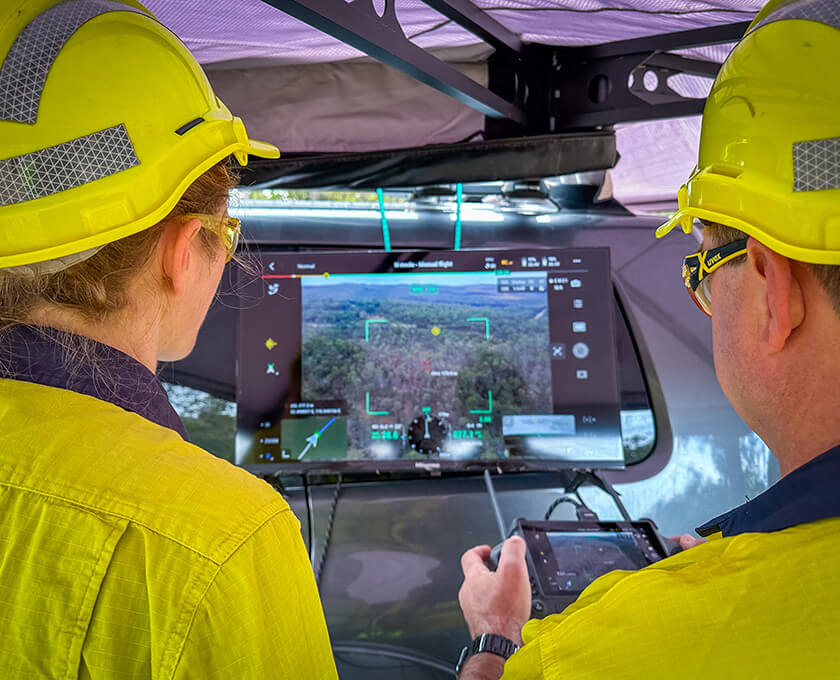September 13, 2024
Sky’s the limit for drone technology

At Alcoa, we are realising the considerable benefits of using drones to carry out a range of tasks across our mining and refining operations. But this is just the beginning of our journey as we explore a multitude of potential opportunities.
From identifying nesting hollows in trees at our mine sites to inspecting confined spaces for repair and maintenance requirements, Alcoa is using drone technology in a range of innovative ways.
According to Senior Digital Specialist and chief drone pilot Andrew King, the technology can provide substantial safety benefits while enabling many tasks to be performed more rapidly and with a greater degree of accuracy.
“Inspections at heights, in confined spaces and in other hard to access locations become far more straightforward,” Andrew said.
“We’re also able to put drones into environments far sooner than we might be able to put people in there because of risks such as chemical or dust exposure and that means we’re seeing significant reductions in downtime and costs.”
Andrew said those factors, along with the ability to overcome resourcing issues, were delivering considerable savings.
“In 2023, cost benefits were in the millions of dollars with one drone operator, and we expect that with additional operators allowing us to address a broader range of tasks, those savings could be increased significantly when deployed across the entire business,” he said.
“This is helping is become safer, smarter and faster in the ways we operate. We’re training more people to use drones so they can enhance ways they approach a range of everyday tasks.”
Andrew says the innovation is not in the drones themselves, which he describes as nothing more than “flying selfie sticks”, but in the range of accessories that can be used with them. That includes high-tech cameras and sensors, as well as tools for detection, collection and carrying equipment.
He said such technology allowed drones to be used for wear and corrosion inspections, while thermal imaging technology could spot potential issues and even assist in determining the size of tree hollows used for nesting by animals including black cockatoos.
“Thermal imaging allows us to determine the size of hollows, indicating if they are likely to be used as habitat so we can identify trees to be protected before mining gets underway,” Andrew said.
While artificial intelligence and machine learning technologies are advancing to enable autonomous flying, Andrew said many of the current applications required highly skilled operators with training typically lasting between six and nine months for dedicated pilots. That allows drones to be manoeuvred in hard to access locations and to take high-resolution photos and videos to inform repair and maintenance requirements.
However, he says “citizen pilots” require less comprehensive training and can rapidly realise the benefits of introducing drones into their workflows.
“When I first helped with mine surveying work there was a bit of concern that we’d be replacing people with drones,” Andrew said.
“But two years later we’ve increased the mine survey team from three to 10 people and they’re using drones quite comprehensively because of the valuable data that can be collected, analysed and used to inform continuous improvement in the ways we manage our mining operations.
“Coupled with our Power BI application, we can analyse large volumes of geological, hydrological and other data quickly to make very precise decisions.”
With costs for drones and associated equipment ranging from anywhere between $500 and $150,000, Andrew says operating safely and with precision is vital, hence the requirement for comprehensive training.
Over the past five years, there have been just two casualties – and to unlikely predators. Andrew says eagles will readily attack drones that fly into their territory but fortunately the two drones that became prey were lower cost models. Nevertheless, Alcoa’s drone pilots are taught about “escape and evasion” procedures and know to stay out of the air if eagles are spotted in the vicinity.
The future options are broad. Andrew says embracing autonomous operations and machine learning are on the cards to assist with tasks such as scheduled inspections and surveillance operations.
“There are some exciting machine learning opportunities, including identifying exceptions,” Andrew said.
“That means instead of having to monitor hours of footage, we can be alerted to the issues and act quickly and efficiently to avoid potential problems or resolve them. That could be as simple as looking for rocks or potholes on haul roads, through to identifying unplanned movement of animals, equipment or people across site, or alerting operators to potential leaks.”
Alcoa has explored various remote sensing technologies to improve and streamline rehabilitation design, execution and monitoring. Successful trials have led to the integration of drones to assist with monitoring requirements.
A project that is underway is investigating the use of drones to inspect established areas of post-mining rehabilitation. Under the rehabilitation completion criteria that Alcoa works to, target numbers for native jarrah and marri trees are required per hectare. With hundreds of hectares of rehabilitation occurring each year, resourcing inspections can be challenging. Andrew said the use of drone-mounted sensors to determine different species and identify individual trees from above was showing great promise.
“As people across our operations become aware of how we’re currently using drones, they come to us with new ideas,” he said.
“We’re evaluating the use of autonomous drones for fertiliser delivery across areas being rehabilitated – a task currently requiring the use of helicopters - and are even thinking of things like delivery of spares to machinery operators in the field to further reduce downtime.
“The business is very supportive because there are compelling cases for all the applications we have implemented so far. If anything, we have to narrow down the use cases to prioritise those that can offer immediate benefits with improvements in safety and accuracy being the primary objectives.”